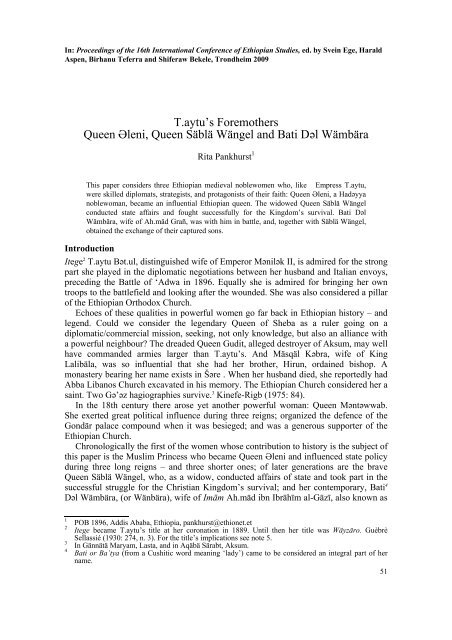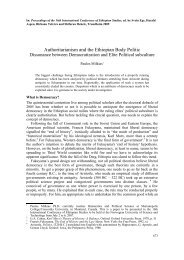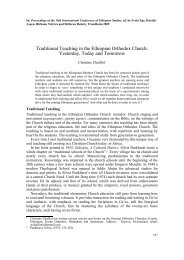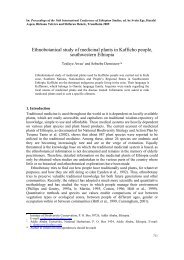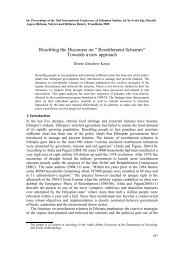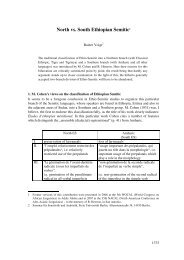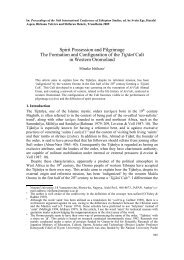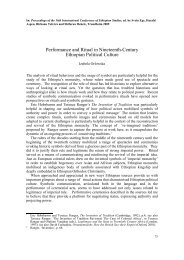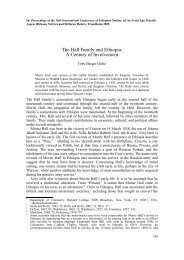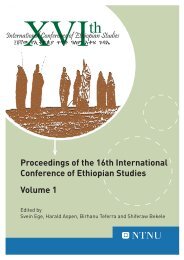T.aytu's Foremothers Queen Əleni, Queen Säblä Wängel ... - portal svt
T.aytu's Foremothers Queen Əleni, Queen Säblä Wängel ... - portal svt
T.aytu's Foremothers Queen Əleni, Queen Säblä Wängel ... - portal svt
Create successful ePaper yourself
Turn your PDF publications into a flip-book with our unique Google optimized e-Paper software.
In: Proceedings of the 16th International Conference of Ethiopian Studies, ed. by Svein Ege, Harald<br />
Aspen, Birhanu Teferra and Shiferaw Bekele, Trondheim 2009<br />
T.aytu’s <strong>Foremothers</strong><br />
<strong>Queen</strong> <strong>Əleni</strong>, <strong>Queen</strong> <strong>Säblä</strong> <strong>Wängel</strong> and Bati Dəl Wämbära<br />
Rita Pankhurst 1<br />
This paper considers three Ethiopian medieval noblewomen who, like Empress T.aytu,<br />
were skilled diplomats, strategists, and protagonists of their faith: <strong>Queen</strong> <strong>Əleni</strong>, a Hadəyya<br />
noblewoman, became an influential Ethiopian queen. The widowed <strong>Queen</strong> <strong>Säblä</strong> <strong>Wängel</strong><br />
conducted state affairs and fought successfully for the Kingdom’s survival. Bati Dəl<br />
Wämbära, wife of Ah.mäd Grañ, was with him in battle, and, together with <strong>Säblä</strong> <strong>Wängel</strong>,<br />
obtained the exchange of their captured sons.<br />
Introduction<br />
Itege 2 T.aytu Bət.ul, distinguished wife of Emperor Mənilək II, is admired for the strong<br />
part she played in the diplomatic negotiations between her husband and Italian envoys,<br />
preceding the Battle of ‘Adwa in 1896. Equally she is admired for bringing her own<br />
troops to the battlefield and looking after the wounded. She was also considered a pillar<br />
of the Ethiopian Orthodox Church.<br />
Echoes of these qualities in powerful women go far back in Ethiopian history – and<br />
legend. Could we consider the legendary <strong>Queen</strong> of Sheba as a ruler going on a<br />
diplomatic/commercial mission, seeking, not only knowledge, but also an alliance with<br />
a powerful neighbour? The dreaded <strong>Queen</strong> Gudit, alleged destroyer of Aksum, may well<br />
have commanded armies larger than T.aytu’s. And Mäsqäl Kəbra, wife of King<br />
Lalibäla, was so influential that she had her brother, Hirun, ordained bishop. A<br />
monastery bearing her name exists in Šəre . When her husband died, she reportedly had<br />
Abba Libanos Church excavated in his memory. The Ethiopian Church considered her a<br />
saint. Two Gə’əz hagiographies survive. 3 Kinefe-Rigb (1975: 84).<br />
In the 18th century there arose yet another powerful woman: <strong>Queen</strong> Məntəwwab.<br />
She exerted great political influence during three reigns; organized the defence of the<br />
Gondär palace compound when it was besieged; and was a generous supporter of the<br />
Ethiopian Church.<br />
Chronologically the first of the women whose contribution to history is the subject of<br />
this paper is the Muslim Princess who became <strong>Queen</strong> <strong>Əleni</strong> and influenced state policy<br />
during three long reigns – and three shorter ones; of later generations are the brave<br />
<strong>Queen</strong> <strong>Säblä</strong> <strong>Wängel</strong>, who, as a widow, conducted affairs of state and took part in the<br />
successful struggle for the Christian Kingdom’s survival; and her contemporary, Bati 4<br />
Dəl Wämbära, (or Wänbära), wife of Imām Ah.mäd ibn Ibrāhīm al-Gāzī, also known as<br />
1<br />
POB 1896, Addis Ababa, Ethiopia, pankhurst@ethionet.et<br />
2<br />
Itege became T.aytu’s title at her coronation in 1889. Until then her title was Wäyzäro. Guèbrè<br />
Sellassié (1930: 274, n. 3). For the title’s implications see note 5.<br />
3<br />
In Gännätä Maryam, Lasta, and in Aqäbä Särabt, Aksum.<br />
4<br />
Bati or Ba’tya (from a Cushitic word meaning ‘lady’) came to be considered an integral part of her<br />
name.<br />
51
52<br />
Rita Pankhurst<br />
Grañ, the left-handed. She was beside him in battle, negotiated with the <strong>Queen</strong> an<br />
exchange of their captured sons, and agreed to re-marry only on condition that her<br />
prospective husband avenge her first husband’s death.<br />
The primary sources used are: firstly, the Ethiopian chronicles. These, though<br />
sometimes unreliable and not unbiased, are an important, and often the only, source. Of<br />
particular interest is the chronicle of Ah.mäd Grañ, Futūh. al-H.abaša, written by a<br />
Yemeni scribe, known as ‘Arab Faqīh, the “Arab doctor”, who was apparently present<br />
at some of the engagements described. No less valuable are the accounts of two<br />
Portuguese eye witnesses: Alvares, chaplain of the mission of Rodrigo da Lima, 1520-<br />
27, and Castanhoso, a participant in the military mission of Christovão da Gama, 1541-<br />
43. Lastly, there are accounts from Jesuit writers of subsequent decades.<br />
Empress <strong>Əleni</strong>. was married in 1445 and died, probably in her eighties, in 1522.<br />
Earlier called Ite 5 Žan Zela, she came from southern Ethiopia and was the daughter of<br />
the Muslim tributary King Mähmad, who was Gärad 6 of Hadəyya. 7 Her brother was<br />
Mähmad’s rebellious son Mahiko, who later held the same position as his father. She<br />
was given in marriage, probably at a very early age 8 , to the Orthodox Christian, but<br />
nevertheless polygamous. 9 King Zär’a Ya’əqob (1434-1468). 10 The marriage was an<br />
attempt to improve relations with Hadəyya, whose gärad had at times sided with Zär’a<br />
Ya’əqob’s Muslim enemies. Perruchon (1893: 50, 59). The marriage was perhaps<br />
prompted by services rendered to the King by the Hadəyya gärad against the Muslim<br />
ruler of Adäl, and by the increasing importance of the southern regions. Taddesse<br />
(1972: 288, n. 2). 11<br />
Ite Žan Zela was baptized and given the name of <strong>Əleni</strong>. She turned out to be far from<br />
simply a chattel in a dynastic arrangement. Zär’a Ya’əqob must have recognized her<br />
5 Ite, abbreviation of Itege, was a title given, in the 15th and early 16th centuries, to those of the King’s<br />
wives he wished particularly to honour, after a public ceremony comparable to a coronation. Ludolf<br />
(1681: Book 2, Ch.1, 66-69); Basset (1881: Aug.-Sept: 152, n. 178); Perruchon (1894: 173-5). Ite was<br />
also used for noble ladies. Béguinot (1901: 28, n. 2).<br />
6 A title given to the rulers of Muslim or animist territories to the south of the Christian Empire.<br />
Perruchon (1893:16, n. 2; Trimingham (1952:84, n. 2).<br />
7 It is uncertain which area Mähmad governed. Zär’a Ya’əqob’s chronicle refers to Mähmad as Gärad of<br />
Hadəyya. (Peruchon (1893:16, 69). Ludolf (1682: 15) thought that Hadəyya was the name of the<br />
inhabitants of Kämbata: ‘The seventh kingdom is Cambata, the inhabitants thereof are called Hadja or<br />
Hadiens’. Beckingham and Huntingford name him Governor of Hadəyya on p.14 but of Däwaro on<br />
p.525, n.1; however, Cuoq (1981; 171) and Trimingham (1952:82) believe he was Governor of<br />
Däwaro.<br />
8 It was not unusual to arrange marriage contracts between ruling families in which the girl was in, or<br />
not even in, her early teens. As late as 1882, a betrothal was celebrated between the eight-year old<br />
Zäwditu, daughter of the then King Mənilək, and Emperor Yoh.annəs IV’s 15-year old son Ar’aya.<br />
For dynastic marriages, see Pankhurst.(1990:26). Ending military confrontations by arranging<br />
marriages between the male of the stronger party and the young daughter of the weaker one was<br />
practised also by Muslims. Imām Ah.mäd suggested to Ləbnä Dəngəl that he give his daughter to<br />
Ah.mäd in marriage as a sign of friendship. Basset (1881: Aug.-Sept.: 100) but the offer was refused.<br />
On another occasion Ah.mäd s soldiers captured the King’s niece. He made the girl his concubine and<br />
had a child by her, but there were no political consequences. Stonehouse (2003: 347).<br />
9 Polygamy was customary among kings until the end of the 15 th century. The Church tolerated it,<br />
perhaps not daring to challenge the king. Tekle-Tsadik (1966: 165).<br />
10 King Zär’a Ya’əqob had three queens: 1. Žan -Hayla, (her royal name), better known as Gra<br />
Bä‘altih.at (<strong>Queen</strong> of the Left), and also as Fəre Maryam, probably her baptismal name. She was his<br />
favourite, and mother of his eldest daughters. Tekle-Tsadik (1966: 164-6); Perruchon (1893: 54-5); 2.<br />
Žan Zela, or <strong>Əleni</strong>. Perruchon (1893:16, 59); and 3. S.əyon, also known as Admas-Mogäsa (her royal<br />
name). Tekle-Tsadik (1966: 166); Perruchon (1893: 87); Taddesse (1972: 243, n. 2).<br />
11 Taddesse (1972: 288, n. 2) considers it ‘ probable that less notable princesses may have followed<br />
<strong>Əleni</strong> to the Christian Court’. A complaint of the Hadəyya Muslims to Ah.mäd Grañ was that these<br />
marriages were forced on them’. Pankhurst (1997: 206-20).
T.aytu’s <strong>Foremothers</strong><br />
qualities, as she is mentioned as his senior queen, Qäññ Bä‘altih.at, (<strong>Queen</strong> of the<br />
Right) in his chronicle. Perruchon (1893: 59). When his son, Bä’edä Maryam (1468-<br />
1478), came to the throne, he confirmed her in the title, apparently in deference to his<br />
father 12 . In a ceremony following Bä’edä Maryam’s coronation, his wife Žan Säyfa,<br />
received the title of Gra Bä‘altih.at, (<strong>Queen</strong> of the Left), reserved for the king’s<br />
favourite queen. At that ceremony <strong>Əleni</strong> was given the additional name of Admas<br />
Mogäsa, Perruchon (1893:125), though she was usually referred to as Qäññ Bä‘altih.at.<br />
Perruchon (1893:175). Ethiopian <strong>Queen</strong> Mothers were then held in great respect. The<br />
Jesuit Balthazar Tellez affirms: ’As long as the Emperor’s mother lives, if she was<br />
Empress and wife to the Emperor deceas’d, the wife of the Emperor actually reigning is<br />
not called Ethié, but that Honour is always given to the Old One; insomuch that not only<br />
the wife of the new Emperor, but he himself, tho’ he be not her son, calls her Mother, and<br />
Honours her as if she were really so’. Tellez (1710:52).<br />
Empress <strong>Əleni</strong><br />
<strong>Əleni</strong> was, by all accounts, exceptionally gifted. Bä’edä Maryam’s chronicle, albeit<br />
written later, during her ascendancy, devotes many lines to her praise. The scribe<br />
observes that the King was deeply fond of her, for ‘she was accomplished in everything:<br />
in front of God by practising righteousness and having strong faith, by praying and<br />
receiving Holy Communion; in worldly terms, she was accomplished in preparing food<br />
[for the royal table], in familiarity with the books, in knowledge of the law, and in<br />
understanding the affairs of state. For these qualities, the King greatly loved our <strong>Queen</strong><br />
Eléni. He considered her like his own mother’. Perruchon (1893: 175-6). <strong>Əleni</strong> was<br />
married to Zär’a Ya’əqob some years before Bä’edä Maryam’s birth. This, and the fact<br />
that he had lost his mother, would account for the chronicle’s report that he loved<br />
<strong>Əleni</strong>. like his own mother. Taddesse (1972: 288).<br />
<strong>Əleni</strong>. became well-versed in Christian theology. She wrote two religious works:<br />
one on the Laws of God, and the other on the Holy Trinity and the Purity of St Mary.<br />
She also sponsored the translation of Greek and Arabic religious texts into Gə'əz. In daily<br />
life she was kind and pious, keeping the fasts prescribed for monks and nuns.<br />
Beckingham and Huntingford (1961: 394-5). During her regency for her step-grandson,<br />
Ləbnä Dəngəl (1508-1540), many churches were repaired or built.. The most magnificent<br />
was Märt.ulä Maryam in Goğğam, where she held very large estates. Beckingham and<br />
Huntingford (1961:425 and n.2). In the late 15 th and early 16 th centuries this province was<br />
being converted to Christianity. Building a church and endowing a monastery in Goğğam<br />
were the innovations of two queens vying for power: <strong>Əleni</strong>., and Na‘od Mogäsa, Ləbnä<br />
Dəngəl’s mother. Whereas Na‘od Mogäsa affiliated the monastery she endowed, with<br />
the dominant religious movement headed by the Täklä Haymanot Monastery, <strong>Əleni</strong>,<br />
having quarreled with the monks of that monastery, affiliated Märt.ulä Maryam with the<br />
Ewostatewos movement, which was more traditional, and observed the Sabbath. Derat<br />
(2003: 268-72).<br />
12 It was traditionally assumed that <strong>Əleni</strong> had become Bä’edä Maryam’s wife. However, Taddesse<br />
argues, to my mind conclusively, that <strong>Əleni</strong> was never married to Bä’edä Maryam, her husband’s son,<br />
even though she bore the title of <strong>Queen</strong> of the Right during his (Bä’edä Maryam’s) reign. Taddesse<br />
considers that this title was purely ceremonial. Taddesse (1972: 288 and n. 5). That she was given an<br />
additional name, at the ceremony at which the King’s favourite wife, Žan Säyfa, received the title of<br />
Gra Bä‘altih.at, <strong>Queen</strong> of the Left, (Perruchon (1983: 125) can be considered merely a further<br />
ceremonial gesture and would not seem to invalidate Taddesse’s argument.<br />
53
54<br />
Rita Pankhurst<br />
<strong>Əleni</strong>’s edifice was built in great style, in stone and wood, with two tabotat, or altar<br />
stones, of gold. Beckingham and Huntingford (1961: 459, n. 2), 13 Alvares reported that<br />
he had heard from Pero da Covilha, a long-time Portuguese resident at court, who, in<br />
1487, had been sent to Asia to investigate trade possibilities in the East, and had arrived<br />
in Ethiopia around 1507. ‘I quote what he told me and I think he would tell the truth:<br />
that he had gone by order of <strong>Queen</strong> Elena to show how an altar should be made in this<br />
kingdom … and they made this altar of wood and crammed it all full of [solid] gold, and<br />
also the altar stone was of solid gold’. Beckingham and Huntingford (1961: 459).<br />
Märt.ulä Maryam was the church where <strong>Əleni</strong> chose to be buried. Alvares reports: ‘there<br />
was a big guard at that church, who guarded it on account of the great amount of gold<br />
that was in it’. Beckingham and Huntingford (1961: 459). It was, however. looted<br />
shortly after her death, before Ah.mäd’s wars. Guidi (1905: 70-1). The French historian<br />
Marie-Laure Derat suggests that one reason why Märt.ulä Maryam was soon pillaged<br />
was that it was endowed only with gult lands (held by lords or monasteries, who received<br />
the produce of the land, cultivated by others), which depended on the good-will of later<br />
rulers, whereas, had it been endowed with rest lands (inheritable, or held by priests<br />
themselves cultivating the land) looting would not have arisen so soon. It did not happen<br />
when kings endowed monasteries with rəst land. Derat (2003: 250-1).<br />
Märt.ulä Maryam was sacked and burnt by Imām Ah.mäd’s troops in the 1530s, and<br />
again during Oromo incursions in the 1560s, so that nothing remained above ground. The<br />
Jesuit missionary, Manoel d’Almeida, who arrived a century after <strong>Əleni</strong>’s death, left a<br />
detailed description. ‘The ornaments were very rich. There were some chalices and patens<br />
of gold of great weight, and two altar stones of solid gold…I am a witness of this for they<br />
were saved… and came into the hands of Emperor Seltan Cegued [Susnəyos], who kept<br />
them in our house, spending them on restoring this church’. Beckingham and Huntingford<br />
(1954:103-7). According to Almeida, it was subsequently reconstructed on the same<br />
foundations by order of Emperor Susnəyos (1607-1632) in the last years of his reign. The<br />
church is mentioned in his chronicle. Esteves Pereira (1900: Vol. 2, 46). Bell (1988: 126),<br />
based on Almeida and another Jesuit, Balthazar Tellez, suggests a possible reason why<br />
Susnəyos was particularly interested in restoring Märt.ulä Maryam: he was the greatgrandson<br />
of Ləbnä Dəngəl, whom <strong>Əleni</strong> had brought up, and may have wished to restore<br />
that church to perpetuate her memory.<br />
<strong>Əleni</strong> had no children of her own, but this seemed not to have reduced her<br />
importance. She was so widely respected for her character and intelligence that, far from<br />
retiring after her husband's death, she continued to exert political influence and<br />
patronage during the ensuing period of political conflict. Tadesse (1972: 289). She was<br />
at court during the reign of Bä’edä Maryam’s eldest son, Əskəndər (1478-1494). The<br />
palace was at first dominated by his own mother, Romna Wärq (one of Bä’edä<br />
Maryam’s four wives, and the mother of his children). But <strong>Əleni</strong> began to come into<br />
her own as a major influence in state affairs around 1486, and was an important figure<br />
during the reign of her husband’s youngest son, Na’od (1494-1508). At his death she<br />
played a decisive role in choosing twelve-year old Ləbnä Dəngəl (1508-1540) as his<br />
successor, and guided the affairs of state as the most influential of the regents, until he<br />
came of age. Beckingham and Huntingford (1961: 243).<br />
Beckingham and Huntingford, who take a less effusive view of <strong>Əleni</strong>’s personality,<br />
describe her as ‘forceful’ and ‘imperious’, and suggest that she was responsible for the<br />
13 For the history of this church see Bell (1988: 125-9).
T.aytu’s <strong>Foremothers</strong><br />
omission, in the abbreviated chronicle covering Ləbnä Dəngəl’s reign, (Bodleian Bruce<br />
MS 88) of references to him until 1527, when he would have been well into his<br />
majority. They suggest, not altogether convincingly, that ‘She was having no history<br />
written in which she did not play a major part.’ Beckingham and Huntingford (1961:<br />
13-16).<br />
During her regency <strong>Əleni</strong> is best remembered for having foreseen the Christian<br />
State’s growing difficulties with its strategically important Muslim coastal neighbours<br />
to the East, and for trying, unsuccessfully, to maintain peaceful relations with them. The<br />
Ottoman Turks were making their appearance, and the chiefs at the coast were acquiring<br />
far more fire-arms than those possessed by the rulers of the interior. She therefore<br />
sought an alliance with the rivals of the Ottomans, namely Christian Portugal, then a<br />
major power in the Indian Ocean. She made enquiries about that country from Pero da<br />
Covilha. He claimed to Alvares that it was he who had suggested to <strong>Əleni</strong> that she<br />
should send her own embassy to Portugal. Beckingham and Huntingford (1961: Vol. 2,<br />
307). Kleiner (2003: Vol 1, 811-2).<br />
When three Portuguese messengers reached the Ethiopian court in Šäwa in 1508,<br />
they found that Emperor Na‘od had just died. As the new monarch was only eleven or<br />
twelve years old the administration of the country came into the capable hands of the<br />
Dowager <strong>Queen</strong>. The messengers explained the Portuguese difficulties with food<br />
supplies at their base on Socotra Island, and the threat they faced from Egyptian fleets.<br />
<strong>Əleni</strong> was well aware of Christian Ethiopia’s increasing isolation, and the country’s<br />
poor relations with neighbouring Muslim states. She dispatched a letter to the<br />
Portuguese King Manuel, via Afonso de Albuquerque, the Portuguese commander in<br />
India, proposing Ethiopian-Portuguese military co-operation against the Muslims. (Góis<br />
(1949-1955: Vol.3, 221, quoted in Girma and Merid 1964: 23); Tellez (1710:113) She<br />
sent it with an Armenian trader, Mateus, who, after many vicissitudes, eventually<br />
reached Portugal, and delivered the letter to the Portuguese King. Mateus left Portugal<br />
in 1517 with the Rodrigo da Lima Embassy to Ləbnä Dəngəl. It offered the Emperor<br />
some assistance against the incursions of the Muslim Adäl warriors.<br />
However, in that same year the self-confident young Emperor, barely 16 years old,<br />
ignoring <strong>Əleni</strong>’s advice, had gone into battle against the Adäl forces, and had been<br />
victorious, defeating Mah.fūz., Ahmäd’s chief minister. Basset (1881: 142). Continuing<br />
to ignore <strong>Əleni</strong>, Ləbnä Dəngəl showed little interest in obtaining Portuguese help, and<br />
distanced himself from da Lima’s mission. In the early part of the Emperor’s reign help<br />
was in fact not needed.<br />
Thereafter, <strong>Əleni</strong>’s influence declined. She is present, Alvares is told, together with<br />
Ləbnä Dəngəl’s wife, <strong>Säblä</strong> <strong>Wängel</strong>, and his mother, Na‘od Mogäsa, at a Mass<br />
celebrated at Christmas 1520, and at a subsequent questioning of the Portuguese<br />
chaplain on religious matters. He reports that the questions came not only from the<br />
Emperor, but also from the three <strong>Queen</strong>s. Beckingham and Huntingford (1961: 327,<br />
330). The following year, by now into her eighties, <strong>Əleni</strong> is present, described as<br />
‘Mother of the Prester’ [Ləbnä Dəngəl], together with the other two <strong>Queen</strong>s, at the<br />
consecration and re-burial of Emperor Na’od’s bones, ‘each of them [the <strong>Queen</strong>s] with<br />
her black canopy for mourning’. Beckingham and Huntingford (1961: 361), On January<br />
18, 1521, she takes part in the T.əmqät celebrations, under a white canopy. Beckingham<br />
55
56<br />
Rita Pankhurst<br />
and Huntingford (1961: 366). She subsequently retires to her estates in Goğğam, and<br />
dies there in 1522. 14 .<br />
The news of her death reached Alvares, who was at the Court. He reports: ‘They said<br />
that since she had died all of them had died, great and small, and that while she lived, all<br />
lived and were defended and protected; and she was the father and mother of all’<br />
Beckingham and Huntingford (1961: 434). That she was still honoured after her death is<br />
evident from Alvares’s remark that ‘It might be eight or nine months after the death of<br />
<strong>Queen</strong> Elena, who reigned over the greater part of Goiame (Goğğam), that still as many<br />
as came to the Court went to weep at her tent, which was still pitched in its place.’<br />
Beckingham and Huntingford (1961: 425).<br />
<strong>Queen</strong> <strong>Säblä</strong> <strong>Wängel</strong><br />
After <strong>Əleni</strong>'s death Emperor Ləbnä Dəngəl's wife, <strong>Säblä</strong> <strong>Wängel</strong>, began to assume a<br />
significant role in Ethiopian history. The chronicle of Gälawdewos (1540-1559)<br />
proclaims that ‘God inspired in him [in his father, Ləbnä Dəngəl] the love of holy<br />
marriage, which consists in marrying only one wife, in conformity with the canons of<br />
the Christian Church’ Conzelman (1895: 122). This was apparently the case. There is no<br />
record of his having <strong>Queen</strong>s of the Right or of the Left.<br />
During the turbulent latter part of Ləbnä Dəngəl’s reign, the young military genius,<br />
Imām Ah.mäd led a revolt against the Emperor from the Adäl lowlands. At times with the<br />
help of fire-arms, and of Turkish musketeers, the determined Muslim leader launched a<br />
ğihād, conquering more and more of the Christian highlands. The royal family had<br />
constantly to be on the move. Ləbnä Dəngəl belatedly saw <strong>Əleni</strong>’s wisdom, and attempted<br />
to obtain Portuguese military aid, most urgently in 1535, but this was delayed, while the<br />
Adäl advance continued.<br />
In 1539 Fiqtor, <strong>Säblä</strong> <strong>Wängel</strong>’s eldest son was killed in battle, and her fourth and<br />
youngest son, Minas, as well as two of his cousins, were taken prisoner by one of<br />
Ah.mäd’s captains. Basset (1881 Aug.-Sept.:100-1); Girma and Merid (1964: 61).<br />
<strong>Säblä</strong> <strong>Wängel</strong> shared in Ləbnä Dəngəl 's attempts to stem the Adäl tide until he was<br />
forced to find refuge on the impregnable top of Mount Däbrä Damo in Təgray, where he<br />
died in September 1540. <strong>Säblä</strong> <strong>Wängel</strong>'s second son, Gälawdewos, then assumed the<br />
throne at a very young age, Basset (1881 Aug.- Sept.: 103), and the war continued..<br />
News of the Muslim ascendancy in Ethiopia had reached Dom João III in Portugal. He<br />
instructed his Governor of India to send military aid to Ləbnä Dəngəl as soon as possible.<br />
While Gälawdewos was fighting in the south of the country, the long-promised help from<br />
Portugal finally arrived. The Portuguese fleet entered Məs.əwwā in February 1541, five<br />
months after Ləbnä Dəngəl’s death.<br />
The Governor of India, Dom Estevão da Gama, who had arrived in the area, chose four<br />
hundred Portuguese soldiers from among readily available volunteers. They were<br />
accompanied by 150 male servants and attendants. Their weaponry included 600 muskets,<br />
some artillery and several barrels of gun-powder. There was in addition a fife and drum<br />
band. Whiteway (1902: xliv-xlv). Dom Estevão gave the expedition’s command to his 23year-old<br />
younger brother, Christovão da Gama. Both were sons of the explorer Vasco da<br />
Gama. Girma and Merid (1964: 47-48).<br />
14 Some sources state that she died in 1525 (Girma and Merid (1964: 172). It is, possible that Alvares<br />
saw the mourning tents ‘eight or nine months after her death’ on his last court visit, if Ləbnä Dəngəl<br />
was in the area early in 1526.
T.aytu’s <strong>Foremothers</strong><br />
A Portuguese messenger, Aire Dias, who had been in Ethiopia with Rodrigo da Lima’s<br />
mission, was sent to the interior with the news of the arrival of the Experition. He reached<br />
Däbrä Damo, where the widowed <strong>Queen</strong> <strong>Säblä</strong> <strong>Wängel</strong> had remained with her family and<br />
retinue, and with Bahr nägaš Azmač Yəsh.aq. Dias took her urgent plea for help back to<br />
Məs.əwwā. Her son, Gälawdewos, the new Emperor fighting in Šäwa, had been cut off<br />
from her dwindling forces in the north. As the situation worsened she sent two of her own<br />
envoys, Abbethun Kum and Bahr nägaš Yəsh.aq to urge the Portuguese to come quickly<br />
to the aid of her kingdom. Girma and Merid (1964: 47). Whether prompted by her, or on<br />
their own initiative, they advised Dom Christovão to ensure that the <strong>Queen</strong> joined the<br />
expedition. Her presence, they pointed out, would raise the morale of the impoverished<br />
and demoralized local people, and would encourage them to provide food and other<br />
support. Christovão sent back a warm message inviting the <strong>Queen</strong> to join the expedition,<br />
which, he assured her, was there to serve her and her son. He sent one hundred soldiers to<br />
escort her to the camp. Whiteway (1902: 10).<br />
After these negotiations, the Empress, accompanied by some thirty women and fifty<br />
male servants, descended from the top of Däbrä Damo. Escorted by the officers Dom<br />
Christovão had sent to fetch her, she proceeded on mule-back to the Portuguese camp at<br />
Dəbarwa, over 100 km nearer the coast, to review the troops and meet him in person. An<br />
unadorned, accurate account of this meeting was left to posterity by one of its members,<br />
Miguel da Castanhoso. 15<br />
‘She was received by him very nobly, for by his order all were in full dress and in<br />
ranks, the captains with their soldiers, all matchlockmen, with their banners of blue and<br />
white damask with red crosses, and the royal standard of crimson and white damask, with<br />
the cross of Christ heading the rest of the troops. The commander [was]…clothed in hose<br />
and vest of red satin and gold brocade with many plaits, and a French cape of fine black<br />
cloth all quilted with gold, and a black cap with a very rich medal…We saluted her twice<br />
with all the artillery and matchlocks. 16 The queen…was all covered to the ground with<br />
silk, with a large flowing cloak, and some men bore a silk canopy that covered her and the<br />
mule to the ground, with an opening in front of her to see through. She was clothed in<br />
very thin white Indian cloth and a burnouse of black satin, with flowers and fringes of<br />
very fine gold, her head dressed in the Portuguese manner, and so muffled…that only her<br />
eyes could be seen…The queen rode on a saddle with a low pommel, with a stirrup for the<br />
left foot, and the right leg doubled over the pommel, but so covered with her garments<br />
that no one could see the manner of her sitting, and the ladies all riding properly on mules,<br />
muffled in their cloaks’. Whiteway (1902: 17-19).<br />
There followed speeches by the Commander and the <strong>Queen</strong>, before discussions began<br />
in earnest. <strong>Säblä</strong> <strong>Wängel</strong>'s presence rallied support for the Portuguese whom she advised,<br />
encouraging local farmers to supply them with provisions. Perruchon (1894:264). Many<br />
joined the Portuguese to drive out the invader, whose soldiers had burnt numerous<br />
settlements and churches.<br />
Throughout the campaign, until the Commander’s death, Dom Christovão and <strong>Säblä</strong><br />
<strong>Wängel</strong> worked closely together, the <strong>Queen</strong> being consulted frequently. Castanhoso<br />
describes a discussion on strategy held in 1542: ‘When the <strong>Queen</strong> heard of D.<br />
Christovão’s intention she sent for him, and told him that he should not think of daring<br />
15 Descendant of a noble Spanish family, Castanhoso participated in the campaign of 1541-3. His<br />
important testimony was first published in Lisbon in 1564. It was translated into English and edited by<br />
R. S. Whiteway in 1902. Cohen (2003: 694-5).<br />
16 For Fusillades in Ethiopia see Pankhurst 1990:292-3<br />
57
58<br />
Rita Pankhurst<br />
such a great deed with so small an army…that it was less difficult to fight twelve<br />
thousand men in a plain than to capture that hill. To this D. Christovão replied that she<br />
should fear nothing, as they were Portuguese and they hoped to be able … to capture it<br />
with very little loss…With these words she and hers were somewhat pacified and agreed<br />
that D. Christovão should act in the matter as he pleased.’ Whiteway (1902: 32). Even<br />
when morale was low decisions were made jointly: ‘As the grass on this plain was<br />
destroyed, D. Christovão and the <strong>Queen</strong> agreed to advance to camp by a stream that was<br />
near, where there was more refreshment for the wounded, of whom there were more than<br />
sixty’. Whiteway (1902: 51). She was present during a number of battles, tending the<br />
wounded and mourning the dead. Castanhoso reports: ‘While we were in pursuit, the<br />
<strong>Queen</strong> had had a tent pitched and placed the wounded in it; she and her women went<br />
about binding up the wounded with their own head-gear’. Whiteway (1902: 47).<br />
In 1542, some six months after the beginning of the campaign, Imām Ah.mäd, badly<br />
in need of reinforcements, received over 500 Turkish musketeers, and ten field guns -<br />
military support he had requested earlier, from the Pasha of Zabīd in exchange for Minas,<br />
the Emperor’s younger brother, who had been taken prisoner by Ah.mäd in 1539. At the<br />
battle of Wäfla the Portuguese Commander was captured and killed. <strong>Säblä</strong> <strong>Wängel</strong>, Bahr<br />
nägaš Yəsh.aq and some 120 Portuguese narrowly escaped. Girma and Merid (1964; 51).<br />
Her role continued to be important after the Commander’s death: ‘She with her women<br />
felt the greatest grief…The following day she sent for us all, and made a speech consoling<br />
us for our great loss… and this in very discreet and virtuous words’. Whiteway (1902: 72-<br />
3).<br />
In 1543 the remnants of Christovão's force helped Gälawdewos defeat the Muslim<br />
army at the battle of Wäyna Däga, in Bägemder. Esteves Pereira (1888: 61); Tellez (1710:<br />
128-9). Ah.mäd was killed. His widow, Bati Dəl Wämbära, escaped, but her son,<br />
Muh.ammäd, was taken prisoner. Esteves Pereira (1888: 10). A remarkable exchange of<br />
prisoners then took place. The part played by Dəl Wämbära will be described later. <strong>Säblä</strong><br />
<strong>Wängel</strong> 17 was a driving force in the negotiations that let to the exchange of her son Minas,<br />
for Dəl Wämbära’s son, plus a ransom of 1,000 ounces of gold. Esteves Pereira (1888:<br />
41-3). 18<br />
The exchange succeeded, thanks to the joint efforts of the two women, <strong>Säblä</strong> <strong>Wängel</strong><br />
and Dəl Wämbära, despite opposition on both sides. Minas’s chronicle describes the<br />
subsequent festivities the <strong>Queen</strong> organized to celebrate Minas’s return, and those that<br />
were held when his brother, the Emperor, joined them. Esteves Pereira (1888: 42-3).<br />
After a period of consolidation Gälawdewos reigned over a more peaceful kingdom.<br />
There was no Muslim attempt to attack the Christians again for seventeen years.<br />
Huntingford (1989: 135). However, in an effort to conquer Harär, Gälawdewos invaded<br />
Adäl territory and, in 1559, was killed in battle. Minas, who had been living with his<br />
mother, came to the throne. He shared her conservative religious outlook, but was of a<br />
more severe disposition. During his four-year reign <strong>Säblä</strong> <strong>Wängel</strong> continued to be<br />
influential in court and religious affairs.<br />
In the controversy engendered by the Jesuits, who had entered the country during<br />
Gälawdewos 's reign, and were aiming to bring Ethiopia into the Roman Catholic fold,<br />
17 Though Minas’s chronicle describes how the exchange was arranged by <strong>Säblä</strong> <strong>Wängel</strong> and Dəl Wämbära,<br />
that of Galawdewos merely states that it took place, which led the editor, Conzelman, to assume that the initiative<br />
was the Emperor’s. Conzelman (1895:xxiv, 142 and n.3).<br />
18 I am indebted to H.E. Mr. Renato Xavier, Ambassador of Brazil to Ethiopia, for very kindly<br />
translating passages from Esteves Pereira’s Portuguese edition of the Minas chronicle.
T.aytu’s <strong>Foremothers</strong><br />
<strong>Säblä</strong> <strong>Wängel</strong> was a steadfast supporter of the traditionalists who wished Christian<br />
Ethiopia to remain Orthodox. This did not prevent her from interceding on behalf of<br />
foreign Roman Catholics who had fallen foul of the Emperor. Her intervention saved<br />
from execution both the Portuguese adventurer Bermudes, who had angered Gälawdewos<br />
by pressing him to give allegiance to the Pope, and the Spanish Jesuit Patriarch Oviedo,<br />
who had irritated Emperor Minas by siding with the rebellious Yəsh.aq. Girma and Merid<br />
(1964: 62-4).<br />
<strong>Säblä</strong> <strong>Wängel</strong>’s last achievement was to ensure that her grandson Särs.ä Dəngel<br />
(1563-1597), one of several rival contenders, came to the throne. He was thirteen years<br />
old. Her choice was wise, as he succeeded in defending the integrity of the realm<br />
throughout his thirty-four year reign. In 1579, about half way through it, <strong>Säblä</strong> Wängél<br />
died. Conti Rossini (1907: 103 n.) She had been an active participant in the state affairs of<br />
her husband, Lebnä Dəngəl, of her sons, Gälawdewos and Minas, and of her grandson,<br />
Särs.ä Dəngəl. The chronicles mentioning her, extol her piety. Castanhoso reported that,<br />
at Christmas: ‘There were several [friars] in the <strong>Queen</strong>’s trains, some priests and some<br />
friars, for they said Mass wherever she happened to be’ Whiteway (1902: 25); and Särs.ä<br />
Dəngəl’s chronicle refers to her as ‘the great <strong>Queen</strong> who loved fasting and prayer’. Conti<br />
Rossini (1907: 103).<br />
<strong>Säblä</strong> <strong>Wängel</strong> conformed to the model of wise, deeply religious Ethiopian queens who<br />
were involved in state affairs, while retaining the qualities of gentleness and mercy often<br />
attributed to women. It fell to her to live in dangerous times, during which she exhibited<br />
not only diplomatic talents, but also courage and fortitude in battle and defeat.<br />
Bati Dəl Wämbära<br />
Bati Dəl Wämbära, 19 a contemporary of <strong>Säblä</strong> <strong>Wängel</strong>'s, was the youngest daughter of<br />
the famous Amīr, later Imām, Mah.fūz. ibn Muh.ammäd, governor of Zäyla. He was<br />
also the de facto ruler of Adäl. Mah.fūz., a zealous Muslim, who had adopted the title<br />
of Imām because it carried the connotation of spiritual, as well as temporal leadership,<br />
had been conducting raids into the interior that had only temporarily been halted by his<br />
losing one battle. Mah.fūz was able to acquire much booty, including gold and slaves.<br />
He was encouraged by Arab emissaries who proclaimed a ğihād against the Christian<br />
empire, and assisted him with arms and trained soldiers. However, in 1518, Ləbnä<br />
Dəngəl, as we have seen, successfully defeated Mah.fūz.who was then killed in a manto-man<br />
engagement with a Christian soldier turned monk. Beckingham and Huntingford<br />
(1961: 410-15); Trimingham (1952: 83-4); Cuoq (1981: 165-7). Dəl Wämbära grew up<br />
under the shadow of a passionate Muslim father, who led annual looting expeditions<br />
against the Christians.<br />
Probably at an early age she married young Ah.mäd ibn.Ibrāhīm al-Gāzī (ca 1506-<br />
43), a captain in the cavalry guards of the Sultan of Adäl. At eighteen or nineteen,<br />
Ah.mäd had already shown bravery and intelligence. He had restored order within Adäl,<br />
and subdued the Somali nomads. It is not unlikely that Dəl Wämbära saw in him the hope<br />
of avenging her father’s death. As for Ah.mäd, the marriage ensured him the loyalty of<br />
Mah.fūz.’s followers, 20 especially as she ‘became a symbol of succession in the holy war’.<br />
Trimingham (1952: 85-6); Girma and Merid (1964: 37-8); Muth (2003: 155-158).<br />
19<br />
The Arabist, René Basset, in his translation of the Futūh, states that the name Dəl Wämbära means ‘Victory is her<br />
seat’ ‘en éthiopien’. Basset (1897:51).<br />
20<br />
Probably for similar reasons, Ah.mäd married the daughter of the Muslim chief Makatter, ruler of<br />
Mazäga in the west, who asked for assistance against Ləbnä Dəngəl in 1535. The chief controlled a<br />
59
60<br />
Rita Pankhurst<br />
Dəl Wämbära was determined to accompany her husband on the ğihād. He intended to<br />
replace the Christian kingdom by a theocratic Muslim state. Ah.mäd, like Mah.fūz. before<br />
him, had adopted the religious title of Imām in preference to the secular one of Amīr. At<br />
first, Dəl Wämbära’s presence on campaign led to discontent among the soldiers. On the<br />
fourth raid into the highlands Ah.mäd’s chronicler, ‘Arab Faqīh, records: ‘When the army<br />
reached Kub, they said to the Imām: ‘We will not accompany you to Abyssinia unless<br />
your wife Dəl Wämbära returns to the country of the Muslims. She shall not come with us<br />
to the country of the infidels. Not one of the Imāms ever took his wife with him [on<br />
campaign], only you.’ Ignoring the protests of Ah.mäd’s soldiers, Dəl Wämbära<br />
imperiously replied: “I will not go back”.’ So her husband took her as far as Ifat in the<br />
land of the infidels.’ Ifat was at this time held by Christians. Ah.mäd seems for once to<br />
have arrived at a compromise: she was not returned to the safety of Muslim-held territory,<br />
but neither did she remain with her husband. Stenhouse (2003: 32).<br />
After this confrontation the soldiers seem to have accepted her presence on the Imām’s<br />
expeditions. They even tried to present her with some gold, given to them by the people<br />
of Gendebelo, but Ah.mäd would not hear of it, and declared that it was to be used for the<br />
ğihād. Stenhouse (2003: 38-9). She was with him at Ant.okyā [site of one of Ləbnä<br />
Dəngəl’s palaces]. The chronicler reports: ‘In Ant.okyā there was a Christian church,<br />
which the great emirs among the Muslims entered… The Imām entered, as did his wife<br />
Del Wämbära…When they could not find any treasure in it, they set fire to it, and<br />
destroyed it’. Stenhouse (2003: 36).<br />
At times Dəl Wämbära had to be carried on the soldiers’ shoulders Stenhouse<br />
(2003:37), up and down steep and rocky mountain slopes, twice in a state of pregnancy.<br />
In 1531 21 , while, for six days the army camped at Zifah, near Harär, Dəl Wämbära gave<br />
birth to Muh.ammäd, the first of several sons. ‘She deferred going on the expedition on<br />
account of this, and stayed with the Imām’s sister, Munisah’. Stenhouse (2003: 45). In<br />
1532 or 1533, her second son, Ah.mäd an-Nägaši 22 , was born during a campaign in Təgre,<br />
but died shortly afterwards in Särayə. Basset (1897: 51, n. 2); Stonehouse (2003: 350,<br />
373); Huntingford (1989: 122). (Another son, Nas.raddīn, mentioned only in Christian<br />
sources, was governor of Däwaro in 1540 and died after a battle, (by poison or disease).<br />
Muth (2003: 155).<br />
In 1539, when his empire was collapsing, Ləbnä Dəngəl was defeated by Ah.mäd in a<br />
battle in which, as mentioned earlier, the king’s eldest son Fiqtor, was killed and his<br />
youngest, Minas, was captured and taken to Adäl. He was neither castrated nor killed, as<br />
was customary, though he was converted to Islam. According to Minas’s chronicle,<br />
Ah’mad’s counselors advised him to kill Minas, but the Imām went to his wife and told<br />
her what they had said. The two of them decided that the young Minas had not committed<br />
any crime for which he should perish, and that they would treat him well – so well that<br />
‘they would give him their daughter in marriage according to their law’. Some scholars<br />
have suggested that Dəl Wämbära ‘tried to create here some sort of transition of power’<br />
and that the marriage was part of this plan. Chernetsov (2003: 505). After the celebrations<br />
Ah.mäd’s counselors pointed out the political folly of allowing his daughter to be Minas’s<br />
wife. Some time later, when Ah.mäd was in need of reinforcements, they persuaded him<br />
force of some 15,000 Nubians.<br />
21 According to Muth (2003: 155) Muh.ammäd was born in 15 27.<br />
22 Ah.mäd an-Nägaši was the name of one of the first Ethiopian followers of Islam, whose grave is in<br />
Təgre. Trimingham (1952: 152). It is significant that the Imām, and/or Dəl Wämbära, chose this name<br />
for their second child, born in Təgre. Basset (1897: 51.n. 2).
T.aytu’s <strong>Foremothers</strong><br />
to send the Emperor’s son and cousins as a gift to the Turkish Pasha of Zabīd [in Yemen],<br />
asking in return for soldiers to fight the Färänğ [Roman Catholics, i.e. Portuguese] who<br />
had disembarked at the coast. Dəl Wämbära must have regretted this decision, for<br />
Minas’s chronicle records that ‘on the day he left the camp there was much lamentation<br />
and sadness in the house of Dəl Wämbära’. Esteves Pereira (1888: 38-39).<br />
It is indicative of Dəl Wämbära’s status that, when there was a plot against the Imām,<br />
and the plotters were trying to exile him, they declared, according to ‘Arab Faqīh, that<br />
they must ‘leave the country to us and go away, he and his wife Dəl Wämbära’.<br />
Stenhouse (2003: 103). Subsequently Dəl Wämbära obeyed her husband when, at the<br />
height of his conquests, he commanded his followers to settle their families in the<br />
conquered areas. The Futūh. al-H.abaša mentions that she ‘made preparations for the<br />
journey up’, at a time when not all his soldiers showed similar willingness. Stenhouse<br />
(2003: 331).<br />
As mentioned earlier, in 1543 the Imām’s army was routed, by the combined forces of<br />
Emperor Gälawdewos and the remnants of the Portuguese expedition. Ah.mäd was killed<br />
and Dəl Wämbära’s eldest son, Muh.ammäd, was captured. Dəl Wämbära fled to the<br />
north-west of Lake T.ana together with Nūr ibn al-Muğāhid, son of Ah.mäd’s sister.<br />
Eventually Dəl Wämbära succeeded in returning to Harär, then at the centre of Adäl<br />
power. Her first task was to make arrangements for the exchange, as we have seen, of her<br />
son, then some twelve years old, for Emperor Gälawdewos's brother, Minas. Conzelman<br />
(1895: 142). Dəl Wämbära was in a good position to achieve this ambition because<br />
Minas's life had earlier been spared through her intervention. It was no easy task,<br />
however, as his captors feared, rightly, as it turned out, that if released, he would come to<br />
the throne, and be a powerful enemy.<br />
The exchange took place the following year, 1544. 23 Minas’s chronicler wrote that the<br />
Lord inspired Dəl Wämbära to consider the return of Minas and to send a message to the<br />
<strong>Queen</strong> suggesting the exchange of their sons. They agreed with much good will for they<br />
were both overjoyed as mothers. Dəl Wämbära dispatched a message to the Pasha of<br />
Zabīd urging him to support the exchange, which he did, after consulting the Sultan and<br />
asking for 1,000 ounces of gold in addition. <strong>Säblä</strong> <strong>Wängel</strong> then ordered much gold to be<br />
piled up, with the assistance of the princes and noblemen of Təgre, and sent Dəl<br />
Wämbära’s son with the gold. Then the Pasha sent back Minas and his two cousins,<br />
‘because he was compelled by his faith and his greed for gold’. ‘The ships carrying the<br />
sons to be exchanged met in the middle of the [Red] sea: the messengers of the Basha<br />
were in one ship and the messengers of the <strong>Queen</strong> were in another. The agreement was<br />
concluded by oath. The release was simultaneous, and there was neither first nor last, for<br />
fear of treachery’. Esteves Pereira (1888: 41-2).<br />
Soon after Ah.mäd’s death, his nephew, Amīr Nūr, who, with Dəl Wämbära, had<br />
succeeded in returning to Harär, asked her to marry him, as was expected of a Muslim<br />
whose close male relative had died leaving a widow. She replied: ‘If you want to marry<br />
me, go and kill that Christian king, the murderer of my husband.’ Basset (1894: 107).<br />
Nūr was eventually to fulfil her demand in a battle in 1559, Basset (1881 Aug.-<br />
Sept.:103); Burton (1894: Vol. 2, 11-12) whereupon the marriage took place. Thereafter<br />
no more is heard of Dəl Wämbära.<br />
One may speculate, given Dəl Wämbära’s dynamic character, that she was involved in<br />
her second husband’s achievement, when as Amīr of Harär, he built the wall around the<br />
23 Chernetsov (2003: 505) gives the date of the exchange as 1547.<br />
61
62<br />
Rita Pankhurst<br />
city that is still visible in places today. Leaving aside all speculation, Bati Dəl Wämbära<br />
was one of the most famous women of the Horn of Africa in the 16 th century. She<br />
emerges from the Futūh., and from the royal chronicles, as a strong-willed woman,<br />
working in tandem with her husband. She was capable of mercy in cruel times, but her<br />
great achievement was her successful diplomacy that resulted in the unprecedented<br />
exchange of important prisoners, negotiated by two noble and brave ladies.<br />
Conclusion<br />
Enough has been said to demonstrate that Empress T.aytu’s undeniable achievements<br />
were by no means unique among consorts of Ethiopian kings (and prominent chiefs).<br />
All three women who figure in this account were skilled diplomats; all three were strong<br />
supporters of their faith. At least two of them were no strangers to the battlefield. They<br />
show that, long before the great T.aytu came to the fore, Ethiopians accepted the notion<br />
that women, whether they bore children or not, could be strong, independent decisionmakers,<br />
accepted and respected as leaders.<br />
References<br />
Basset, René. 1881. ‘Études sur l’histoire d’Éthiopie.’ Journal Asiatique, Vol. 17, Aug-<br />
Sept. 93-389.<br />
—— 1897. Histoire de la conquête de l’Abyissinie. Paris: Leroux.<br />
Beckingham, Charles Fraser, and George Wynn Brereton Huntingford. 1954. Some<br />
Records of Ethiopia. London: Hakluyt Society.<br />
—— 1961. The Prester John of the Indies, tr., rev. Cambridge: University Press.<br />
Béguinot, Francesco. 1901. La cronaca abbreviata d’Abissinia. Roma: Casa Edit.<br />
Italiana.<br />
Bell, Stephen. 1988. ‘The Ruins of Mertola Maryam’. In: Proceedings of the Eighth<br />
International Conference of Ethiopian Studies, Vol.1. Addis Ababa: Institute of<br />
Ethiopian Studies.<br />
Burton, Richard Francis. 1894. First Footsteps in East Africa. London: Tylston and<br />
Edwards.<br />
Chernetsov, Sevir. 2003. ‘Bati Del Wämbära’. In: Encyclopaedia Aethiopica, Vol. 1.<br />
Wiesbaden: Harrasowitz.<br />
Cohen, Leonardo. 2003.‘Castanhoso, Miguel de’. In: Encyclopaedia Aethiopica, Vol.1.<br />
Wiesbaden: Harrasowitz.<br />
Conti Rossini, Carlo. 1907. Historia Regis Sarsa Dengel (Malak Sagad). Louvain:<br />
CSCO.<br />
Conzelman, William Elliot. 1895. Chronique de Galâwdêwos. Paris: Bouillon.<br />
Cuoq, Joseph. 1981. L’Islam en Êthiopie. Paris: Nouvelles Éditions Latines.<br />
Derat, Marie-Laure. 2003. Le domaine des rois éthiopiens (1270-1527). Paris:<br />
Sorbonne.<br />
Esteves Pereira, Francisco Maria. 1888. Historia de Minas. Lisboa: Imprensa Nacional.<br />
Girma Beshah and Merid Wolde Aregay.1964. The Union of the Churches in Luso-<br />
Ethiopian Relations (1500-1632). Lisbon: Junta de Investigações do Ultramar.<br />
Góis, Damião de. 1945-55. Crónica do Felicissimo Rei D. Manuel. Coimbra: Gráfica de<br />
Coimbra, Vol.3
T.aytu’s <strong>Foremothers</strong><br />
Guèbrè Sellassié [Wäldä Arägay]. 1930. Chronique du règne de Ménélik II.. Paris:<br />
Maisonneuve.<br />
Guidi, Ignazio. 1955. Annales Johannis I, Iyasu I et Bakaffa. Louvain: CSCO.<br />
Huntingford, George Wynn Brereton.1989. Historical Geography of Ethiopia. Oxford:<br />
Oxford University Press.<br />
Kinefe-Rigb Zelleke.1975. ‘Bibliography of the Ethiopic Hagiographic Traditions.’<br />
Journal of Ethiopian Studies, Vol. 13(2), pp.57-102.<br />
Kleiner, Michael. 2003.‘Covilha, Pero da’.In Encyclopaedia Aethiopica,Vol.1.<br />
Wiesbaden: Harrasowitz.<br />
Ludolf, Hiob. 1681. Historia Aethiopica. Frankfurt am Main: Zunner.<br />
—— 1682. A New History of Ethiopia. London: Samuel Smith.<br />
Muth, Franz-Christoph. 2003. ‘Ah.mad b. Ibrāhīm al-Ġāzī’. In: Encyclopaedia<br />
Aethiopica, Vol. 1. Wiesbaden: Harrasowitz..<br />
Pankhurst, Richard. 1990. A Social History of Ethiopia. Addis Ababa: Institute of<br />
Ethiopian Studies.<br />
—— 1997. ‘Dynastic inter-marriage in medieval and post-medieval Ethiopia.’ In: K.<br />
Fukui et al. Ethiopia in Broader Perspective: Papers of 13 th International<br />
Conference of Ethiopian Studies, Vol.1. Kyoto: Shokado Book Sellers.<br />
Perruchon, Jules. 1884. Le règne de Galâwdêwos. Paris: Leroux.<br />
—— 1893. Les chroniques de Zar’a Yâ‘eqôb et de Ba’eda Mâryâm. Paris: Bouillon.<br />
Stenhouse, Paul Lester, tr., and Richard Pankhurst, annot. 2003. Futūh. al- H.abaša:<br />
The Conquest of Abyssinia, by ‘Arab Faqīh. Hollywood CA: Tsehai Publishers.<br />
Taddesse Tamrat. 1972. Church and State in Ethiopia 1270-1527. Oxford: Clarendon.<br />
Tekle-Tsadik Mekouria. 1966. Les noms propres, Les noms de baptême et l’étude<br />
généalogique des rois d’Éthiopie (XIII-XX siècles). Belgrade. Mimeo.<br />
Tellez, Balthazar. 1710. The Travels of the Jesuits in Ethiopia. London: Knapton.<br />
Trimingham, John Spencer. 1952. Islam in Ethiopia. London: Oxford University Press.<br />
Whiteway, Richard Stephen. 1902. The Portuguese Expedition to Abyssinia. London:<br />
Hakluyt Society.<br />
63


